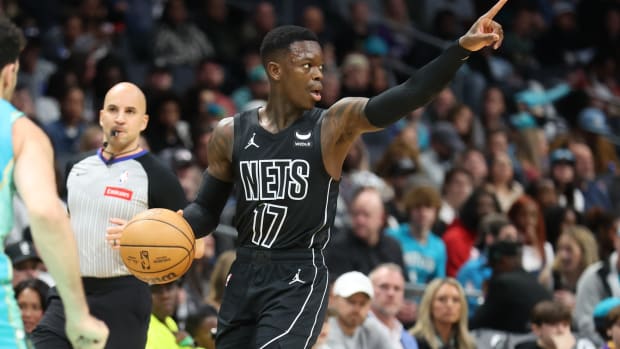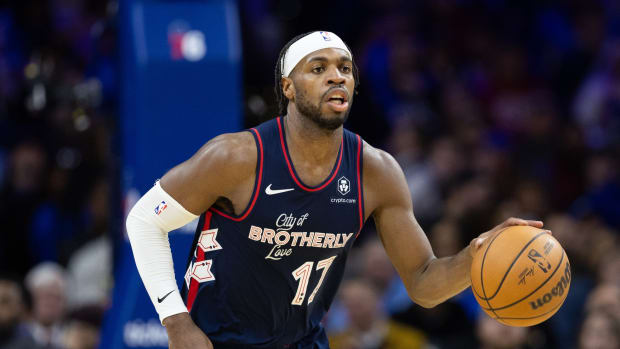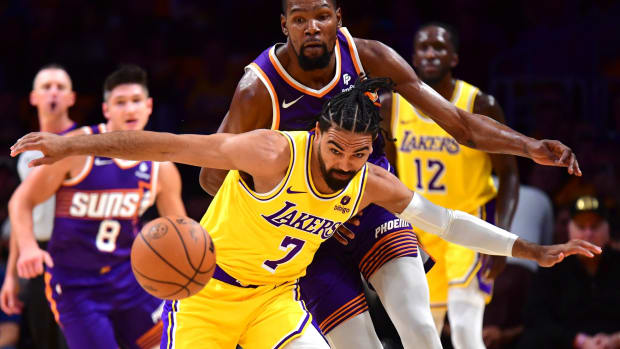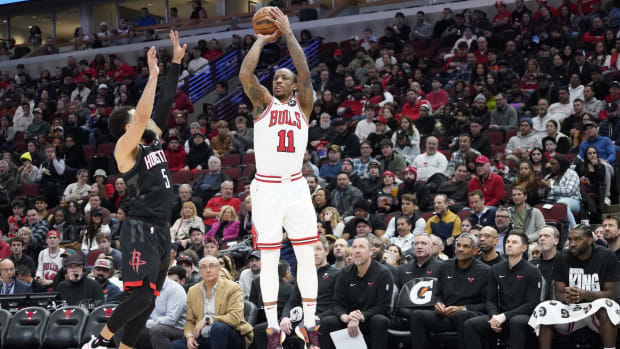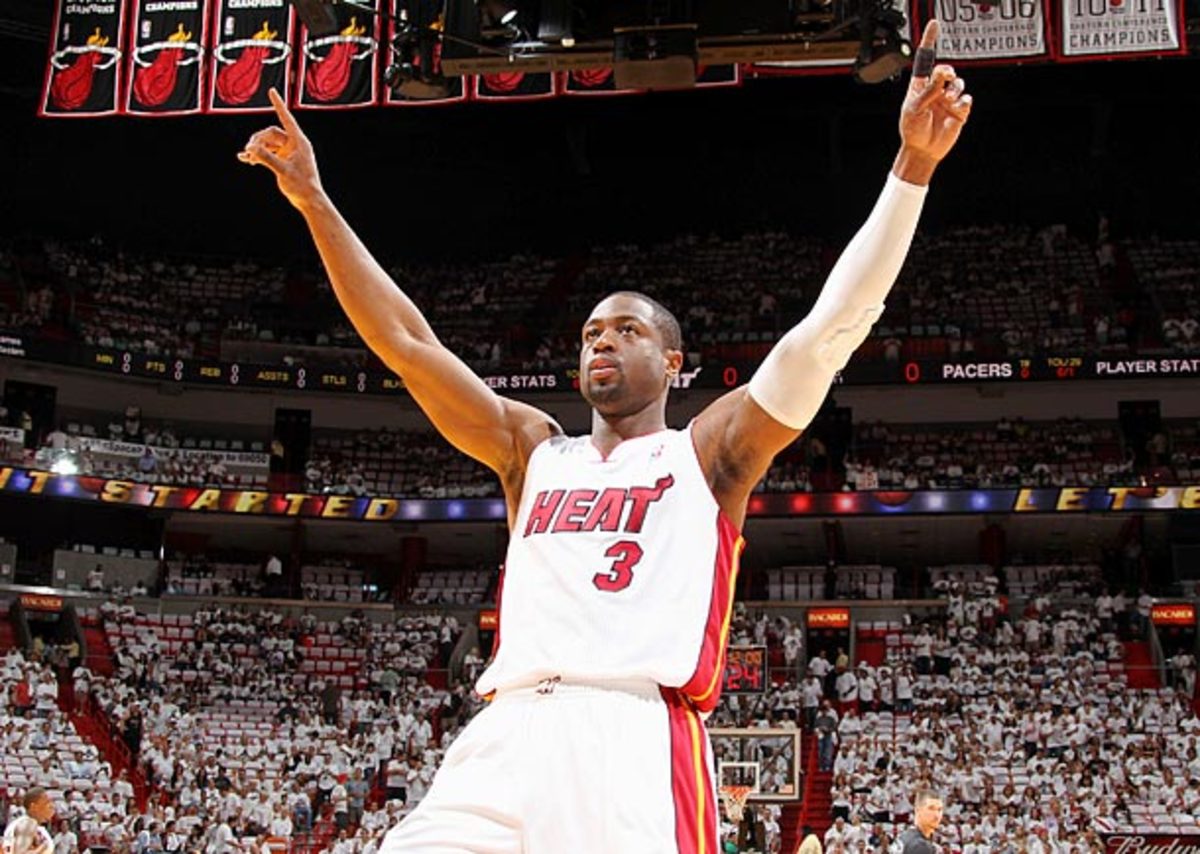
The Fundamentals: Dwyane Wade's resurgence helps fuel Heat's torrid run
Dwyane Wade (right) is shooting a career-high 52.4 percent from the field. (Christopher Trotman/Getty Images)
By Rob Mahoney
LeBron James' impossibly efficient production and the Heat's 22-game winning streak have formed something of a narrative pair, with mention of either accomplishment invoking praise for the other. The association between the two is as strong as it is natural. It's not surprising that team success is so readily linked with the performance of that team's -- and the league's -- best player, while the Heat's torrid run further affirms the incredible work that James does on a regular basis. Both serve as the most exaggerated manifestations of a dominant Heat season.
But their combined headline clout has unfortunately eclipsed the outstanding play of another All-NBA performer. Dwyane Wade isn't quite the player that James is, but his midseason renaissance has been equally responsible for Miami's historic success. It's been a rather stark contrast to Wade's early-season performance, which inspired concern that he may never again stretch to the same superstar heights. Between the perceived after-effects of last season's left-knee injury (which led to surgery in July) and the natural erosion in the game of a 31-year-old hyper-athlete, it seemed plausible that Wade could be riding out the initial stages of a gradual decline. He was still fit to be a key contributor on a contending team, but his sporadic dominance seemingly hinted at the waning arc of an excellent career.
In retrospect, all of that hand-wringing looks rather presumptive. It took some time for Wade to really get cooking, but he's re-emerged as an altogether more efficient player. Although his scoring average has dipped slightly, Wade is shooting a career-high 52.4 percent while maintaining his aggressive scoring style, in part because he remains Miami's most committed dribble-drive threat. Since the Heat's winning streak began six weeks ago, only one perimeter player (the now-injured Tony Parker) has averaged more field-goal attempts in the restricted area than Wade. But what sets Wade apart is his rate of conversion (a whopping 73.6 percent) on those attempts, which dwarfs that of any high-usage finisher not named LeBron James or Blake Griffin. If Wade ever lost a step, it feels safe to say that he's found it again.
All in all, that very focus has allowed Wade to put up some impressive numbers, including an active string of 13 consecutive 20-point games (all but one of which featured 50 percent shooting or better). That streak may seem paltry next to the statistical feats that James has accomplished this season, and to some extent it is. But let's not forget that Wade has been able to score efficiently and consistently while contributing in so many other areas, working against time restraints (because of semi-frequent blowouts) and thriving alongside such a prolific teammate.
That last point is the most important of all, as the Heat's unbelievable play throughout the winning streak has rather emphatically confirmed their offensive authority. Oklahoma City is a tremendous offensive team, but the Thunder still experience some hiccups because of a lack of structural aid. Denver, too, can pile up points, but the Nuggets remain prone to terrible dry spells that allow opponents to sneak back into games that should be decided. Even mighty San Antonio has struggled when opponents are able to lock up Parker's drives and remain committed to defending the corners.
None of this is meant to imply that Miami is a team without weakness, but in relative terms the Heat's problems seem rather trivial. Because of an evolving collaboration between Miami's players and coach Erik Spoelstra, the Heat have found an optimal, flexible offense that can disassemble even the most technically profound defensive systems. The harrowing thing about playing the Heat is the sense of inevitability that comes along with it; James and Wade are so skilled and so well-supported that high-level execution is the out-and-out norm, leaving opponents to tackle imposing individual disadvantages while contending with the Heat's perfectly intuitive play structure.
Much of that might still be possible if James were leading the Heat without Wade or vice versa, but the growth of those two stars toward one another has provided the basis for the Heat's juggernaut ascent. Forget James' season for the ages or Wade's revival for a moment, and consider the one number that matters more than anything else: With James and Wade on the floor, the Heat score at a ridiculous rate of 119.9 points per 100 possessions -- 22.5 points better than their opponents. The Heat nearly lead the league in offense as it is, but when you distill their overall play to only those lineups involving their two best players, they begin to lap the rest of the field in scoring efficiency. Take a look at the Heat's overall shooting performance when James and Wade are on the floor together:
That chart is downright tropical, and a reminder that this offense isn't merely good -- or merely great. Miami's best lineups have been decimating opponents the last few months. Even if Wade and James hadn't developed such wonderful synergy, players such as Shane Battier and Ray Allen create spacing and scoring options that are practically impossible for opponents to counter. Crowding the drive surrenders a wide-open three-pointer to a deadeye shooter. Double-teaming Wade or James in the post yields a good look to a cutter or a release-pass to Chris Bosh for an easy jumper. Focusing on Wade only creates more opportunities for James, and at this point focusing on James really doesn't do much of anything. Opponents simply have too many threats with which to contend, and Wade and James are capable of leveraging their skills and the space available to turn any possession into a successful one.
Play of that caliber has the illusion of being self-evident, as if the impact of every superstar player were so great and obvious as to be immediately seen. But Wade and James, after a few years together and a healthy period of trial and error, have created such a rich and complex dynamic that it serves as the underpinning of all that the Heat have done during this remarkable season and all that they will do in their run toward a second straight title.
Kendrick Perkins (5) has missed nine of his 30 dunk attempts this season. (Layne Murdoch/NBAE via Getty Images)
GO FIGURE
• The anticlimax of a missed dunk is one of basketball's simplest pleasures, as we step back from a display of otherworldly athleticism to delight in the blunder of botching a sure two points. When it comes to that area of entertainment, two players stand apart in pure volume: DeAndre Jordan (18) and JaVale McGee (17) lead the league in dunks missed this season, in part because both rank in the top three in dunks attempted. But when looking at dunks made and attempted in the form of a percentage, Kendrick Perkins, Danny Green and Jeff Pendergraph rank as the league's least thorough finishers around the basket. Thank you all for your contributions to the world of NBA bloopers, and may you continue to punctuate otherwise successful careers with these occasional moments of levity.
• Every bad team winds up being good at something, but I was nonetheless shocked to find that the Bobcats rank third in the league in free-throw rate -- thanks largely to Ramon Sessions, who has crept into the top 10 in attempts at 5.7 per game. It's an impressive and sneaky feat, and the kind that might mean something if Charlotte didn't rank last in both effective field-goal percentage (which factors in the added value of three-pointers) and effective field-goal percentage allowed.
• Brandon Jennings is in the midst of a stretch that fans -- and Bucks interim coach Jim Boylan, I'd suspect -- wish could last. In his last nine games, Jennings has averaged 16 points and 11.2 assists, at times looking the part of the heady playmaker that many hoped he'd be. Jennings has had stints like this before, though, so we'll see how long he can sustain this type of play.
No. 1 pick Anthony Davis (right) has seen his minutes increase in March. (Danny Johnston/AP)
NOTES FROM AROUND THE ASSOCIATION
1. Second-guessing Monty Williams
Williams has had a curious follow-up to his promising first two years as Hornets coach, replete with odd lineup choices and uninspired strategic options. Nevertheless, it's good to see Williams coming around a bit on Anthony Davis' playing time, even if it's evident that he still holds an odd characterization of the rookie big man's slight frame. Despite playing just 17 minutes against the Lakers and 16 minutes against the Wizards (two teams with strong centers and big front lines overall) in recent weeks, the No. 1 pick in last year's draft is averaging 30 minutes in March after dropping to 25 in January and 26 in February.
Davis makes mistakes and isn't a perfect matchup for all opponents, but opting for Robin Lopez instead of him seems to reward arbitrary advantage (physical strength) over actual production. In March, Davis has averaged 19.9 points (on 52.8 percent shooting), 12.8 rebounds and 2.2 blocks per 36 minutes; Lopez's numbers are far more meager. The Hornets' defense is actually slightly better this season with Davis on the court. There's no question that Davis is an incomplete player without the savvy of more experienced players, but for how long can Williams artificially cap his best young player's minutes for the sake of playing a merely passable big man?
2. A modest proposal
Consider this my humble request to the Naismith Memorial Basketball Hall of Fame for the recognition of last Wednesday's Bulls-Kings game as an event of sport-wide significance. Chicago has lost its way a bit of late, but no amount of straying should result in Sacramento -- a team firmly committed to its own disarray -- taking a 45-point lead on one of the best defensive teams in the league en route to a 121-89 victory. I've never seen anything quite like this implosion. All I know is that when a good team comes within a Nate Robinson bailout of losing by 50 to the Kings, it deserves more than cursory notice on a packed Wednesday schedule.
Corey Brewer smiling? Nothing new there. (Chris Humphreys/USA Today Sports)
3. Deron Williams lives again
Even looking beyond his ridiculous 42-point, 11-three-pointer game against the Wizards, there's plenty of reason to be pleased with Williams' recent performance. Brooklyn signed Williams to a max contract with the expectation that he would play to that level, but he didn't sniff that mark until the last couple of weeks. Williams has been too underwhelming this season for us to jump for joy at the portent of a solid short stretch, but as a fan of the flex-empowered Jazz iteration of Williams, I'm hoping -- though not optimistic -- that he will crawl back toward his previous form on a more regular basis.
4. Corey Brewer, staunchly against mean mugging
There are plenty of things to enjoy about the Denver swingman's energized game, but today I offer only a single question in regard to the man: Is Brewer the single smiliest player in the NBA?
5. Woe be Pablo
Coach Mike Woodson has a lot on his plate with the Knicks' many and worrisome injuries, but I can't figure out whey he remains so reluctant to play reserve guard Pablo Prigioni. In the absence of a team's primary shot creators, the role of ball-handlers and playmakers becomes that much more important. Raymond Felton becomes a crucial piece as one of the few Knicks who can create anything off the dribble. J.R. Smith jacks up 20 shots a game because he has the skills to manufacture shots from broken action and the conscience to accommodate those decisions. But otherwise, New York is struggling mightily to get anything going on offense, while one of the team's best passers wastes away on the bench. It's not a game-to-game problem, per se, though I fail to understand why Prigioni occasionally goes unused throughout games in which he might actually be able to help.
6. Another tough break for Rodrigue Beaubois
It never fails. Just as the Dallas guard starts to gain any momentum, he suffers a serious injury that derails his progress, kills his confidence and begins his ascent anew after a lengthy rehabilitation. The latest: Just days after reclaiming a spot in the Mavericks' rotation with an 18-point, five-assist outing, Beaubois entered a game against the Thunder and promptly broke his left index finger. The 25-year-old has convincing NBA skills, but as long as his development continues to be set back by injury, he'll toil away on the fringes of the rotation.
7. The accidental brilliance of Raymond Felton
At full speed and from a wide angle, Felton looked like a ball-handling wizard on Sunday when he seemingly whipped a pass through Chris Paul's legs to an open Kenyon Martin. But a closer look offers something even better: Felton's pass was actually a botched dribble that completely got away from him and just so happened to bounce in the one spot that prevented Paul from picking up a steal and triggering a fast break. Felton actually had a pretty decent game overall, but something about his wobbling dribble-drive style lends itself perfectly to this kind of flub.
8. Thomas Robinson changes his number, keeps mum
After the Rockets picked up the recently waived Aaron Brooks, Houston newcomer Robinson agreed to forfeit jersey No. 0 to his veteran teammate. To replace it, the rookie picked No. 41, which I had hoped was a doff of the cap to Dirk Nowitzki (a fellow power forward with an unconventional game) or a loving tribute to the brief Celtics tenure of Michael Olowokandi. As it turns out, it was neither. Though Robinson wouldn't divulge specifics on the significance of his number choice, he did note to Jonathan Feigen of the Houston Chronicle that it's a reference to his hometown of Washington, D.C. Any ideas, Washingtonians?
Statistical support for this post provided by NBA.com.



































